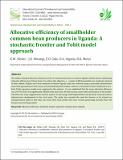| dc.contributor.author | KW Sibiko, JK Mwangi, EO Gido, OA Ingasia, BK Mutai | |
| dc.date.accessioned | 2020-08-27T09:11:22Z | |
| dc.date.available | 2020-08-27T09:11:22Z | |
| dc.date.issued | 2013 | |
| dc.identifier.uri | https://repository.maseno.ac.ke/handle/123456789/2443 | |
| dc.description.abstract | The study evaluated allocative efficiency levels of common bean farms in Eastern Uganda and the factors influencing
allocative efficiencies of these farms. To achieve this objective, a sample of 480 households was randomly selected
in Busia, Mbale, Budaka and Tororo districts in Eastern Uganda. Data was collected using a personally administered
structured questionnaire with a focus on household decision makers; whereas a stochastic frontier model and a twolimit Tobit regression model were employed in the analysis. It was established that the mean allocative efficiency
was 29.37% and it was significantly influenced by farm size, off-farm income, asset value and distance to the market.
Therefore the study suggested the need for policies to discourage land fragmentation and promote road and market
infrastructure development in the rural areas. The study also revealed the need for farmers to be trained on
entrepreneurial skills so that they can invest their farm profits into more income generating activities that will
harness more farming capital. | en_US |
| dc.publisher | ISDS LLC, Japan | en_US |
| dc.subject | Allocative efficiency, Stochastic frontier approach, Common bean, Uganda | en_US |
| dc.title | Allocative efficiency of smallholder common bean producers in Uganda: a stochastic frontier and tobit model approach | en_US |
| dc.type | Article | en_US |

